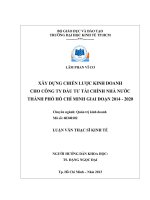Slide Investment 2020 (Đầu tư tài chính)
Bạn đang xem bản rút gọn của tài liệu. Xem và tải ngay bản đầy đủ của tài liệu tại đây (4.63 MB, 279 trang )
Investment
• Lecturer: Nguyen Thanh Huong
• Email:
1
Course description
Number of hours: 45 (3 credits)
Level: Undergraduate
Aims:
Provide students with a fundamental and advanced knowledge
of investment theory
To guide students in the practical application of investment
analysis
To demonstrate to students the techniques of financial
valuation
2
Course outline
• Chapter 1:
Introduction to Investment
• Chapter 2:
Portfolio theory
• Chapter 3:
Asset pricing models
• Chapter 4:
Stock analysis and valuation
• Chapter 5:
Bond analysis and valuation
3
Grading
Class Preparation/Participation:
20%
Regular attendance
5%
Participation in class
5%
Two short tests
10%
Test 1: Chapters 1-2
Test 2: Chapters 3-5
Assignment and presentation in class
20%
Final exam
60%
4
Materials and manuals
Manuals:
Bodie, Z., Kane, A., Marcus, A. J., Essentials of Investments, Fifth
Edition
Reilly, F. K., Brown, K. C., Investment Analysis and Portfolio
Management, 7th Edition, Thomson - South Western, 2003.
Chapter 1 – 2, 6 – 16, 19
5
Chapter 1
INTRODUCTION TO INVESTMENT
6
Chapter 1:
Intro to Investment
1.
2.
3.
4.
5.
6.
Investment definition
Financial assets vs Real assets
Major classes of financial assets
Investment process
Measuring the return and risk of an investment
Utility, Risk Aversion and Portfolio selection
7
1. Investment Definition
An investment is the commitment of current resources in
the expectation of deriving greater resources in the future.
Investment example:
Buying a stock/bond
Putting money in a bank account
Study for a college degree
8
1. Investment Definition
The nature of financial investment:
Reduced current consumption
Planned later consumption
An investment will compensate the investor for:
The time the funds are committed
The risk of the investment
Inflation
9
2. Real Assets versus Financial Assets
Real Assets
Assets used to produce goods and services: Buildings, land,
equipment, knowledge…
Real assets generate net income to the economy
Financial Assets
Claims to the income generated by real assets: stocks, bonds…
Define the allocation of income or wealth among investors
10
3. Major Classes of Financial Assets
Debt securities: Money market instruments, Bonds
Equity security: common stock, preferred stock
Derivatives: Options, Futures, Forward, Warrants.
Alternative investments: Real estate, artwork, hedge funds,
venture capital, crypto currencies, etc.
11
4. Investment Process
Portfolio: an investor’s collection of investment assets.
Two types of decisions in constructing the portfolio:
Asset allocation: Allocation of an investment portfolio across
broad asset classes
Security selection: Choice of specific securities within each asset
class
Security analysis: Analysis of the value of securities
12
5. Measuring Return and Risk
5.1. Measuring return
Holding-period Return (HPR)
Arithmetic Mean (AM) vs. Geometric Mean (GM)
Risk and Expected return
5.2. Measuring risk
Measuring risk using variance and standard deviation.
5.3. Measuring risk and return of a portfolio
The return of a portfolio
Correlation and portfolio risk.
13
5.1. Measuring Return
Return:
Profit/loss on an investment.
Can be expressed in $$$ or in percentage (%).
Rate of return = return expressed in %.
From now on, “rate of return” will be simply called “return”
(Unless specified otherwise).
14
5.1. Measuring Return
Holding-Period Return (single period):
P1 + D1
HPR =
−1
P0
P0 = Beginning price
P1 = Ending price
D1 = Dividend during period one
15
5.1. Measuring Return
Example 5.1
You bought a share of Vingroup for VND 50,000 on 01/09/2017. And
then you sold it for VND 75,000 after 1 year. What is the HPR on
your investment?
75,000
𝐻𝑃𝑅 =
− 1 = 0.5 = 50%
50,000
16
5.1. Measuring Return
Example 5.2
You bought a share of Hoa Phat for VND 40,000 on 01/09/2017 and
sold it 1.25 year (15 months) later for VND 75,000. What is the HPR
on your investment?
75,000
𝐻𝑃𝑅 =
− 1 = 0.875 𝑜𝑟 87.5%
40,000
Which investment performed better?
17
5.1. Measuring Return
Holding period: day, week, month, year, etc.
How to compare HPRs with different holding periods?
How to measure the average return over multiple periods?
18
5.1. Arithmetic Mean vs. Geometric Mean
Arithmetic Mean:
n
AM =
i=1
HPR i
n
Geometric Mean
1
n
n
GM =
1 + HPR i
−1
i=1
19
5.1. Arithmetic Mean vs. Geometric Mean
Example 5.3: Mutual fund DUE has the following returns in the last 4
years as follow: 35%, -25%, 20%, -10%.
What is the mutual fund’s AM?
35% − 25% + 20% − 10%
𝐴𝑀 =
= 5%
4
What is the mutual fund’s GM?
𝐺𝑀 =
1 + 0.35 1 − 0.25 1 + 0.2 1 − 0.1
1
4
−1
𝐺𝑀 = 2.26%
20
5.1. Arithmetic Mean vs. Geometric Mean
If an investor invests in the DUE fund, what return should
he expect to earn next year?
Which number is better at representing the actual
return/performance of the DUE fund for the last 4 years?
Arithmetic Mean or Geometric Mean?
21
5.1. Arithmetic vs Geometric Mean
Example 5.4
AM = [1+(–0.50)] /2 = 0.5/2 = 0.25 = 25%
GM = (2 × 0.5)1/2 – 1 = (= (1)1/2 – 1 = 1 – 1 = 0%
22
5.1. Expected return and Risk
Example 5.5
W1 = 150 Profit = 50
W = 100
1-p = .4
W2 = 80 Profit = -20
Risk is uncertainty regarding the outcome of an investment
23
5.1. Expected return and Risk
Risky Investment with three possible returns
24
5.1. Expected Return
The return that investment is expected to earn on average.
𝑛
𝐸 𝑅𝐴 =
[𝑃𝑟𝑜𝑏𝑎𝑏𝑖𝑙𝑖𝑡𝑦 𝑜𝑓 𝑅𝑒𝑡𝑢𝑟𝑛 × 𝑃𝑜𝑠𝑠𝑖𝑏𝑙𝑒 𝑅𝑒𝑡𝑢𝑟𝑛]
𝑖=1
𝑛
𝐸 𝑅𝐴 =
𝑝𝑖 𝑅𝑖
𝑖=1
𝑤ℎ𝑒𝑟𝑒
𝑝𝑖 is the probability of scenario i,
𝑅𝑖 is the return of investment A in scenario i.
25









